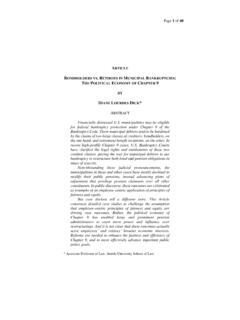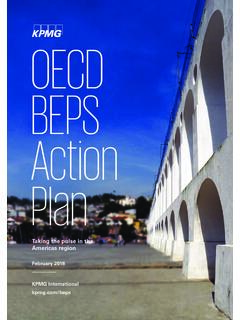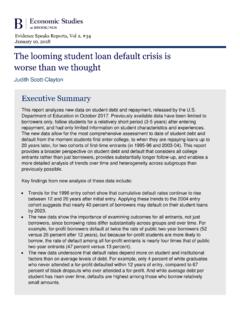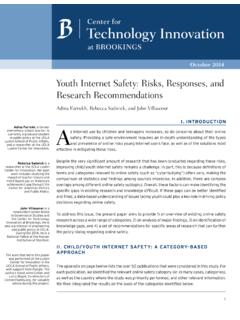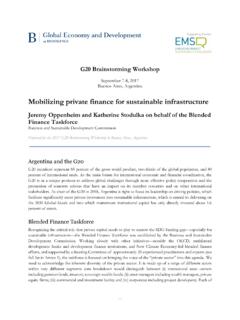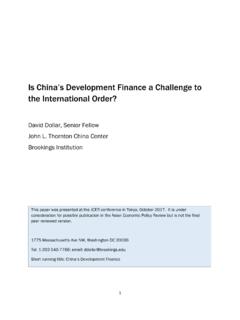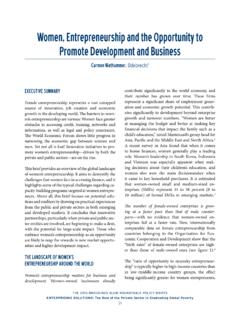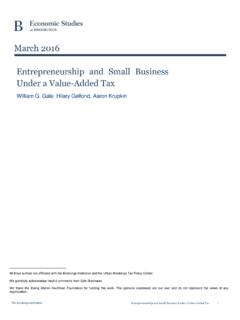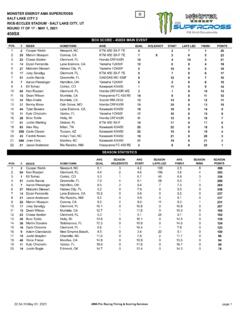Transcription of The Ridesharing Revolution: Economic Survey and Synthesis
1 The Ridesharing Revolution: Economic Survey and Synthesis Robert Hahn and Robert Metcalfe* January 10, 2017 Paper prepared for Oxford University Press Volume IV: More Equal by Design: Economic design responses to inequality. Eds. Scott Duke Kominers and Alex Teytelboym. Abstract Digital Ridesharing platforms, such as Uber and Lyft, are part of a broader suite of innovations that constitute what is sometimes referred to as the sharing economy. In this essay, we provide an overview of current research on the Economic efficiency and equity characteristics of Ridesharing platforms, and provide a research agenda that includes an examination of the natural evolution toward driverless cars.
2 We have three main findings: first, relatively little is known about either the equity and efficiency properties of Ridesharing platforms, but this is likely to change as companies and researchers focus on these issues. Second, we may be able to learn something about the likely diffusion and benefits of these technologies from experience with other policies and technologies. Third, while we believe these platforms will do substantially more good than harm, the measurement, distribution, and size of the gains from these technologies requires further research.
3 * Robert Hahn is professor and director of economics at the Smith School at the University of Oxford, a non-resident senior fellow at Brookings, and a senior fellow at the Georgetown Center for Business and Public Policy. Robert Metcalfe is Postdoctoral Research Scholar in Economics at the University of Chicago. We would like to thank Ted Gayer, Jonathan Hall, Scott Kominers, Jonathan Meer, Alex Teytelboym, Scott Wallsten, and Cliff Winston for helpful comments and Julia Schmitz, Brian Campbell and Samantha van Urk for excellent research assistance.
4 The usual caveat applies. The Ridesharing Revolution: Economic Survey and Synthesis Robert Hahn and Robert Metcalfe 1. Introduction Digital Ridesharing platforms, such as Uber and Lyft, are part of a broader suite of disruptive, matching market innovations that constitute what is sometimes referred to as the sharing economy (Sundararajan, 2016). Other examples of the sharing economy include Airbnb, for short-term room and apartment rentals, and WeWork, for renting shared office space. While there is not one widely agreed definition of the sharing economy, it often involves attempts to make more efficient use of labor and capital resources through the use of information technology that lowers the costs of matching buyer with sellers.
5 In this note, we provide an overview of current research on the Economic efficiency and equity characteristics of Ridesharing platforms, and suggest areas for research including the move toward driverless cars. We focus on platforms that connect drivers, who generally use their personal vehicles, with These platforms, thus, help to create a market by matching buyers and sellers of Ridesharing services. Our review is not meant to be exhaustive, but is intended to highlight some of the most important insights in this area as well as potential research opportunities.
6 Section 2 provides a brief overview of Ridesharing and its growth. Section 3 discusses equity and efficiency impacts of Ridesharing and discusses the future of Ridesharing . Finally, section 4 briefly concludes. 2. Ridesharing : It s not what it used to be 1 Thus, we do not consider services such as Zipcar. 2 Ridesharing is not new. It began during World War II. In 1942, the government required Ridesharing arrangements in workplaces when no other transportation options were available in order to save rubber during the war (Chan and Shaheen, 2012).
7 In the 1970s, the oil crisis and spike in gasoline prices encouraged another period of ride sharing. However, today s Ridesharing revolution was made possible by the development of GPS, smart phone technology, and electronic payments. In the early 1990s, Kowshik et al. (1993) envisioned a future of Ridesharing similar to what exists today that would use better matching techniques to provide dynamic Ridesharing . Ridesharing platforms connect drivers and vehicles with consumers who want rides at an agreed Typically, a customer uses an app on her smartphone to request a ride at a particular time and place.
8 The app on the phone then walks the customer through a series of steps, including the actual or expected price of the ride, the location of the driver, and the likely wait time. It also allows the customer or the driver to contact each other without giving out personal information. These platforms take advantage of GPS to arrange for the ride and help determine a driver s best route. They also provide other benefits for riders and drivers, including measures of rider and driver quality to foster trust (Luca, 2016), and an efficient payment system, frequently using a credit card that is entered into the platform s data base.
9 The platforms also can help balance demand and supply by adjusting prices in real time to accommodate shortfalls in the supply of drivers or surges in demand. Ridesharing companies are able to implement pay flexibility (Wood, 1989), a term that refers to a firm s ability to adjust labor costs, particularly wages, to changing market conditions. In exchange for providing these various services, Ridesharing platforms like Uber and Lyft take a percentage of the fare for each ride. The may vary between 0% and 30% of the ride fare, most often around 20%-25% (Huet, 2015).
10 3 2 Ridesharing companies are sometimes called ridesourcing companies or transportation network companies. 3 Uber and Lyft were not the first companies in the new era of Ridesharing . One of the first companies appears to be Avego in 2007--now Carma ( ). 3 There is evidence that that employment from offering rides is becoming a more important part of the economy, especially in large metropolitan areas4 Furthermore, there is evidence that the use of Ridesharing platforms is growing rapidly.
